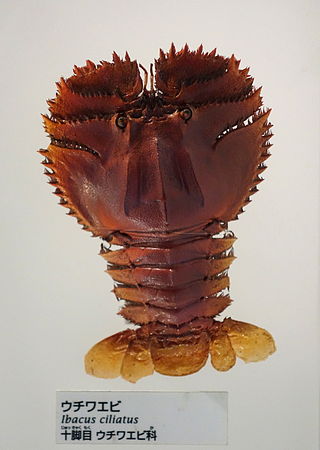Eunephrops bairdii is a species of marine lobster, commonly called the "red lobster", endemic to the Caribbean Sea. It is found off the coasts of Colombia and Panama at depths of 230–360 metres (750–1,180 ft). It reaches a length of up to 20 centimetres (7.9 in), which is equivalent to a carapace length of 4–9 centimetres (1.6–3.5 in), but is apparently too scarce for commercial exploitation.

Thenus orientalis is a species of slipper lobster from the Indian and Pacific oceans.

Ibacus peronii, the Balmain bug or butterfly fan lobster, is a species of slipper lobster. It lives in shallow waters around Australia and is the subject of small-scale fishery. It is a flattened, reddish brown animal, up to 23 cm (9 in) long and 14 cm (6 in) wide, with flattened antennae and no claws.

Metanephrops japonicus is a species of lobster found in Japanese waters, and a gourmet food in Japanese cuisine. It occurs from Chōshi, Chiba Prefecture (Honshu) to the east coast of Kyushu, where it lives at depths of 200–440 metres (660–1,440 ft). Adults grow to a total length of 9–12 centimetres (3.5–4.7 in), and a carapace length of 3–7 cm (1.2–2.8 in).
Metanephrops boschmai, known as the Bight lobster, Bight scampi or Boschma's scampi, is a species of lobster endemic to Western Australia.

Nephropsis rosea, sometimes called the rosy lobsterette or two-toned lobsterette, is a species of lobster.

Scyllarides latus, the Mediterranean slipper lobster, is a species of slipper lobster found in the Mediterranean Sea and in the eastern Atlantic Ocean. It is edible and highly regarded as food, but is now rare over much of its range due to overfishing. Adults may grow to 1 foot (30 cm) long, are camouflaged, and have no claws. They are nocturnal, emerging from caves and other shelters during the night to feed on molluscs. As well as being eaten by humans, S. latus is also preyed upon by a variety of bony fish. Its closest relative is S. herklotsii, which occurs off the Atlantic coast of West Africa; other species of Scyllarides occur in the western Atlantic Ocean and the Indo-Pacific. The larvae and young animals are largely unknown.
Scyllarides herklotsii is a species of slipper lobster from the Atlantic coast West Africa. It is edible, but is not commercially fished, and is taken only by accident.

Parribacus japonicus, the Japanese mitten lobster, is a species of slipper lobster. Though the common name for this lobster is the Japanese mitten lobster, it is locally called zōri-ebi (ゾウリエビ) – zōri denoting the Japanese sandal it resembles, and ebi meaning shrimp or lobster.
Eunephrops is a genus of lobsters, containing four species, all found in the Western Atlantic Ocean:
Arctides guineensis is a species of slipper lobster that lives in the Bermuda Triangle. It is known in Bermuda as the small Spanish lobster, a name which is also favoured by the FAO.

Scyllarides aequinoctialis is a species of slipper lobster that lives in the western Atlantic Ocean from South Carolina to São Paulo State, Brazil, including the Gulf of Mexico, Caribbean Sea and Bermuda. Its common name is Spanish slipper lobster. It grows up to 30 centimetres (12 in) long, with a carapace 12 cm (4.7 in) long. S. aequinoctialis is the type species of the genus Scyllarides, and the first species of slipper lobster to be described from the Western Atlantic.

Panulirus pascuensis is a species of spiny lobster found around Easter Island and the Pitcairn Islands in the Pacific Ocean. It is known in English as the Easter Island spiny lobster, Langosta de Isla de Pascua in Spanish and Ura in the Rapa Nui language. This lobster is fished on a small scale for local consumption.
Scyllarus pygmaeus is a species of slipper lobster that lives in shallow water in the Mediterranean Sea and eastern Atlantic Ocean. It grows to a length of 55 mm (2.2 in), which is too small for it to be fished for food. The juvenile form was first described in 1885, with the description of the adult following in 1888 as a result of the Challenger expedition.
Eunephrops cadenasi, sometimes called the sculptured lobster, is a species of lobster found in the Caribbean.
Thymopsis nilenta is a species of lobster and the only species in the genus Thymopsis. It is found around the Falkland Islands and South Georgia at depths of 1,976 to 3,040 metres. It reaches a total length of 15 centimetres (5.9 in), of which the carapace makes up about 5 to 6 cm. It is known from a total of four specimens collected from two localities.

Parribacus antarcticus is a species of slipper lobster. Its common names include "sculptured mitten lobster" and "sculptured slipper lobster" in English, and ula-pehu and ula-pápapa in Hawaiian.
Nephropides caribaeus is a species of lobster, the only species in the genus Nephropides. It is found in western parts of the Caribbean Sea, from Belize to Colombia. It grows to a total length of around 170 mm (6.7 in), and is covered in conspicuous tubercles.

Ibacus ciliatus is a species of slipper lobster from the north-west Pacific Ocean.
Jasus frontalis, known as the Juan Fernández rock lobster, is a species of spiny lobster in the genus Jasus, found around the Juan Fernández and Desventuradas Islands in the south-eastern Pacific Ocean.










